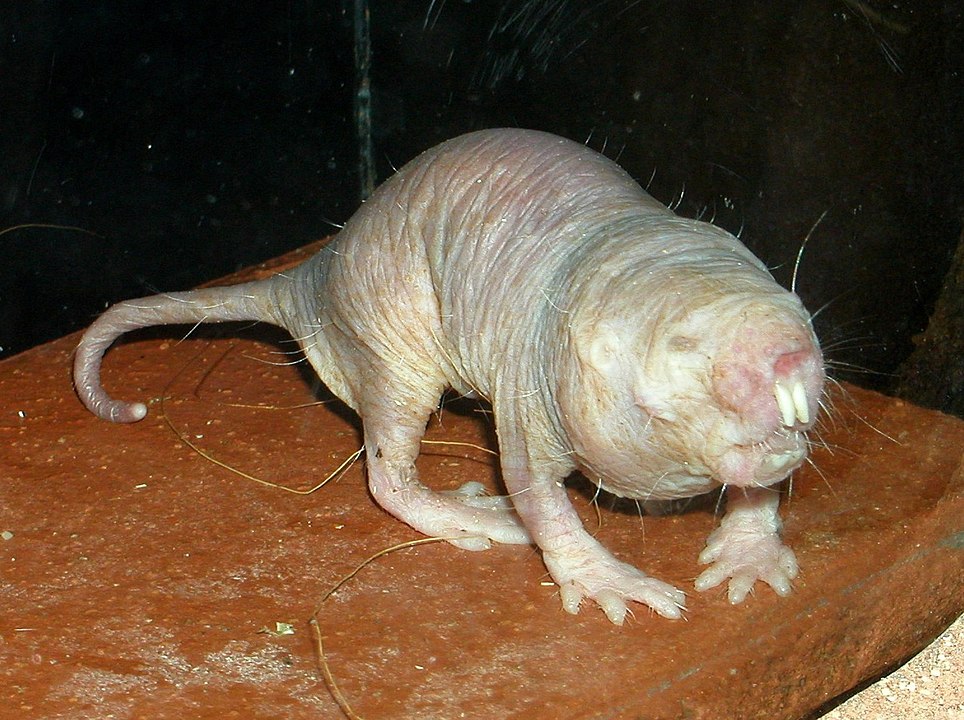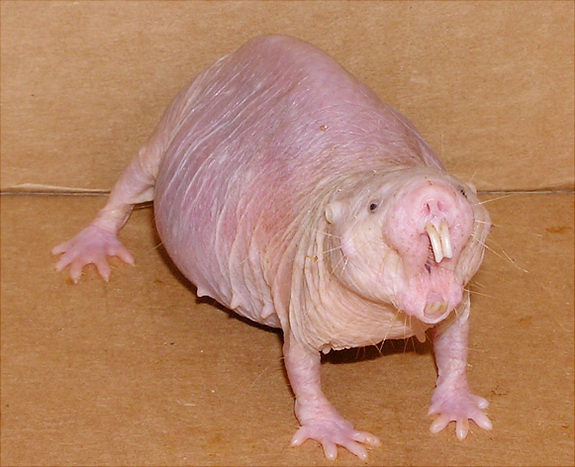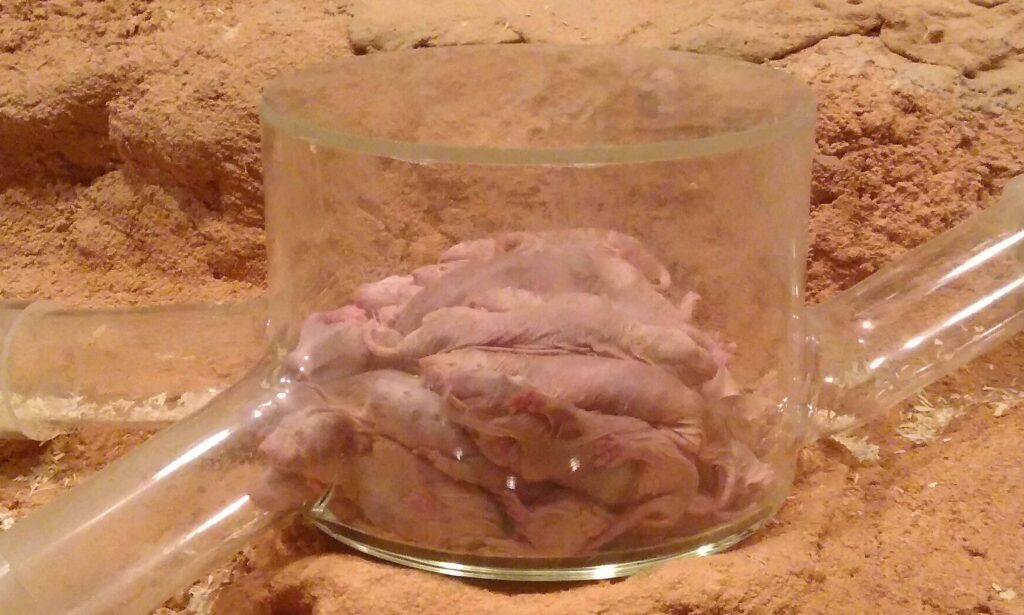Naked mole-rats might not be pretty but they are very interesting. They live underground in large colonies whose social structure resembles ant nests. In addition, their physiology, eternal youth and low susceptibility to disease are interesting to scientists, who hope that studying them will help in the fight against human ailments.
If you rather listen to this post than read it, check out the YouTube video.
Naked, but not hairless
Naked mole-rats are small rodents (not much bigger than a mouse) that live in East Africa. Like moles, they live underground, but in my opinion, they don’t really look like rats.
Naked mole-rats don’t have the typical mammalian fur, but like us (and like rat tails) they are not completely hairless.
Their whole body is sparsely covered in sensory, whisker-like hairs. The animal can sense in which direction and how much these hairs are bent, giving them information about their surroundings and speed and direction of their movement.

Social life
Naked mole-rats live in large colonies of up to 300 individuals (although on average about 80). Only one female queen (rarely two) and one to three males reproduce. The rest of the colony members are workers, who perform jobs such as caring for the young, digging and maintaining tunnels, finding and transporting food and nest lining material, and defending the colony.
When a female becomes a queen, her body elongates to accommodate the many young she gets (up to 28 in a litter). Other females in the colony do not reproduce, but are not infertile. When the queen dies, one of the workers takes her place, usually after a (deadly) fight with others. Rarely one of the workers kills the queen and take her place. Sometimes larger males or females leave their colony to start a new one.
Colony members recognise each other by smell, and also communicate through sound. Naked mole-rats have a very rich vocal repertoire. When two individuals meet in a corridor face-to-face, they greet each other with quiet ‘chirps’, and the number of signals depends on their social status.

Life underground
Digging tunnels
Naked mole-rats spend all their lives underground. They build extensive systems of corridors (even over 3km in total) with sleeping chambers, larders and toilets.
They have short paws that make it easy to move in narrow corridors, but unlike the mole they do not use them for digging. They use their protruding incisors for that. When the animal digs, the lips fold behind the teeth (see picture below) so that soil does not get inside the mouth. They may also close their nostrils to prevent soil getting into their nose.
Digging tunnels is a team effort. One individual digs and then pushes the soil under its body and kicks it back with its feet. Others then transport the earth to the tunnel exit by pushing it with their hind feet while moving backwards. When they reach the tunnel exit, another individual kicks it outside. On the surface it looks a bit like an erupting volcano.
Searching for food
The length and number of corridors in a colony depends on the colony size and the availability and distribution of food. Naked mole-rats are vegetarians. They mainly eat roots, tubers and other underground storage organs of plants. They do not seem to be able to sense them through the soil, and only find them when they come across them accidentally when digging corridors. Therefore, many tunnels are created mainly to find food.
Small plant parts can be eaten right away or taken to the storage chambers. Larger roots (in these regions they can grow up to 50kg) are only nibbled on, so that the plant can survive and continue to grow. After a while, the gnawed holes are filled with soil so that the plant can regenerate. In this way, colonies of naked mole-rats can stay in one place for years and don’t run out of food.
Poorly regulated body temperature
The temperature in the burrow is virtually always around 28-30°C. The body temperature of naked mole-rats is only a few degrees higher, and the animals have largely lost the ability to regulate it. If they are removed from their burrow and kept individually at a lower temperature, their body temperature also drops. But they survive and can even reproduce.
Most mammals (like us) can maintain a constant body temperature using physiological processes. In the naked mole-rat these processes don’t work so well. They have brown fatty tissue that they can convert to heat, but under natural conditions, it is mainly their behaviour that helps them keep their body temperature constant. To warm themselves, they stay close together (often in big groups, one on top of the other) or wander into corridors closer to the surface. To cool down, they seek colder tunnels.

Resistance to lack of oxygen
Living underground with limited ventilation and in large groups means that the air naked mole-rats breathe is often low in oxygen and high in carbon dioxide. However, these animals appear to be resilient to these conditions.
They can survive periods of very low oxygen concentration in the air (even up to 18 minutes completely without oxygen). This is probably thanks to their small brain, low metabolism, and slow heartbeat. When the oxygen concentration decreases, naked mole-rats can slow down these processes even further.
Thanks to various physiological adaptations, high concentrations of carbon dioxide are not a problem either. The naked mole-rats can survive for up to 5 hours in a concentration of 80% carbon dioxide. In comparison, the maximum recommended concentration for humans is 0.15%.
Eternal youth
Although most rodents of similar size live only a few years, naked mole-rats live up to 30 years (at least in the laboratory). And, more surprisingly, they show no signs of aging during this time.
Unlike humans and other rodents, naked mole-rats have a very low incidence of cancer, osteoporosis, cardiovascular disease or neuro- and other degenerative diseases. Further, the incidence of these diseases does not increase with age for them.
Naked mole-rats also show low susceptibility to most infections, except viral diseases (for example, caused by coronaviruses), which lead to high mortality.
Many scientists are studying the longevity, high resistance to cancer and other features of naked mole-rats’ physiology, hoping that someday this knowledge will help save human lives.
But I hope that the above text shows that these animals are interesting not only from a medical point of view.
Main sources of information:
“The Encyclopedia of Mammals” Ed. D. W. Macdonald
Buffenstein et al. (2022) “The naked truth: a comprehensive clarification and classification of current “myths” in naked mole-rat biology”
Check out also my onother post: Did you know that naked mole-rats have dialects?
Photo credits (from top to bottom): Von Ltshears – Eigenes Werk, Gemeinfrei, https://commons.wikimedia.org/w/index.php?curid=1568930; Von Roman Klementschitz, Wien – Eigenes Werk, CC BY-SA 3.0, https://commons.wikimedia.org/w/index.php?curid=252701; By Uploaded by Jedimentat44 on flickr. – https://www.flickr.com/photos/jedimentat/7557258168/sizes/o/in/photostream/, CC BY 2.0, https://commons.wikimedia.org/w/index.php?curid=25045157; Magdalena Kozielska-Reid
Polską wersję tego wpisu możesz znaleźć tutaj.


very nice, thank you Magdalena.
I have always been fascinated by them in the zoo, next time I’ll understand better what I see.
Do you think they miss the digging in the artificial environment of the zoo?
An interesting question. My guess would be yes as I saw them at the zoo trying to bite the plastic tunnels. Maybe that’s why they are sometimes given wood chips to move around.